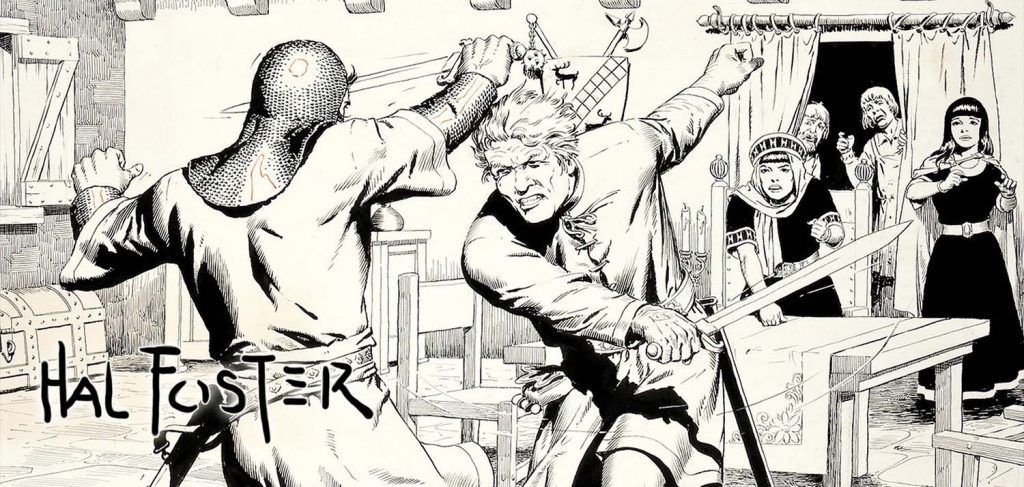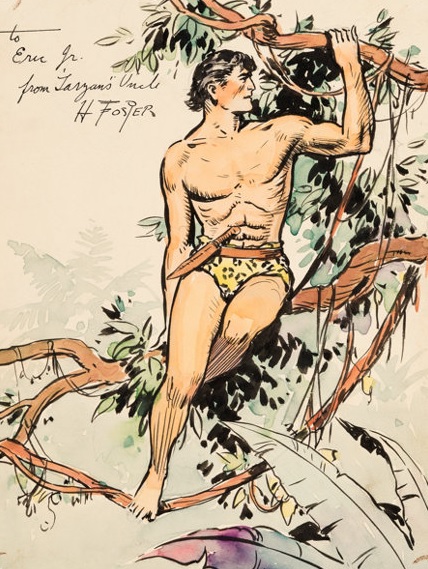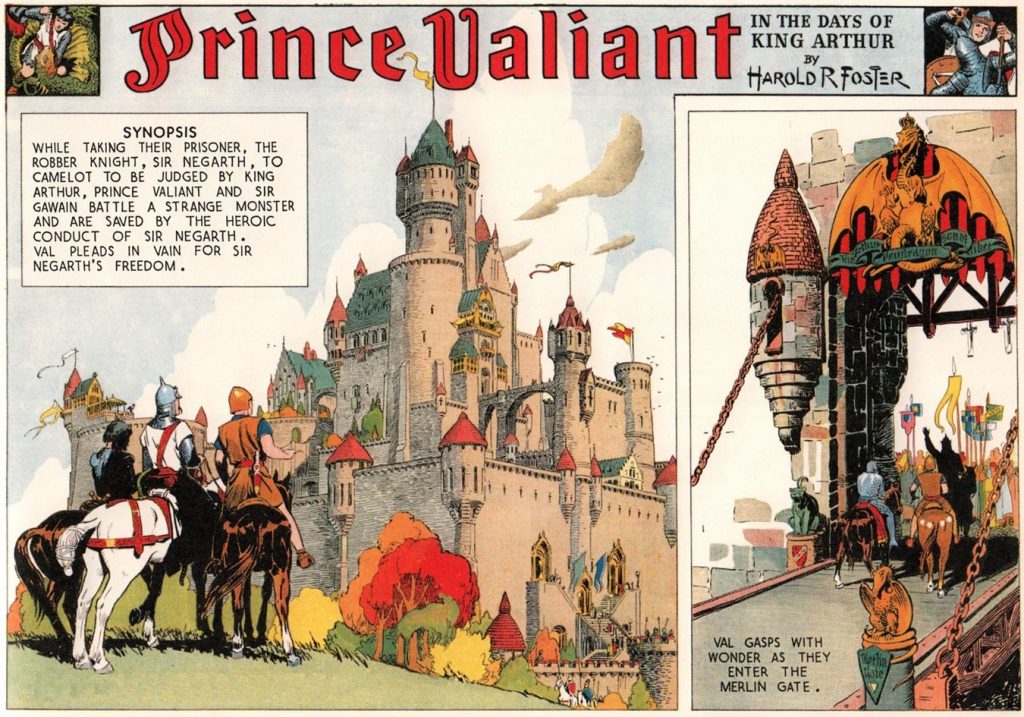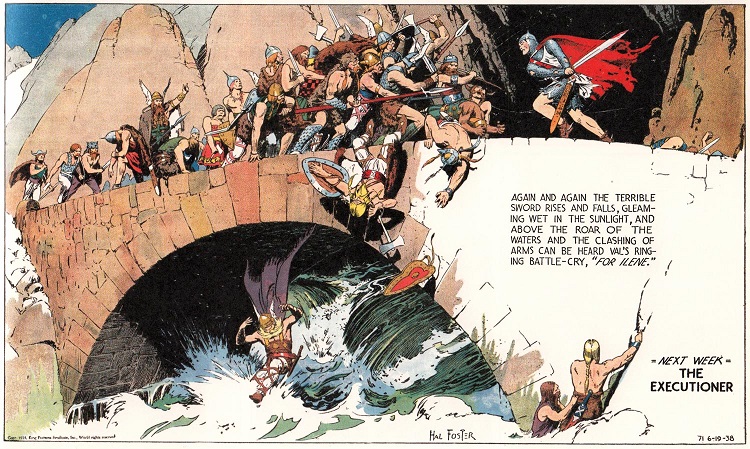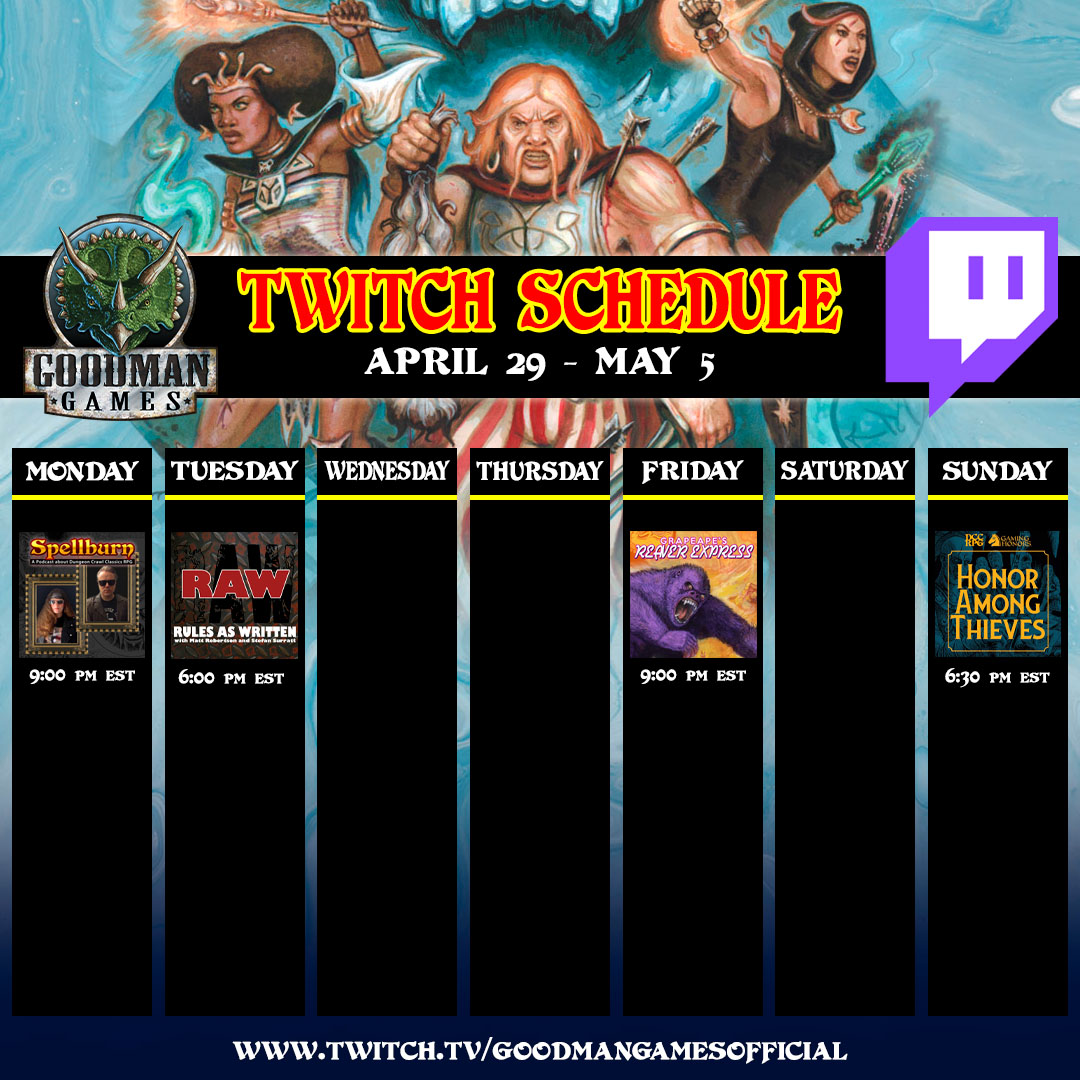A Profile of Hal Foster
by Joshua LH Burnett
When discussing Appendix N and its influence on role-playing adventure games, comic strips are rarely brought up. But comics like Buck Rogers, Terry and the Pirates, and the adaptation of Edgar Rice Burrough’s Tarzan are foundational works of the American science fiction and adventure genres. Hal Foster is one of the fathers of the modern adventure comic, and if you don’t know his name, you’ve almost certainly heard of his most famous creation, Prince Valiant.
Harold Rudolph “Hal” Foster was born in Halifax, Nova Scotia in 1882, the youngest son of Edward and Jaeanette Foster. After his father’s death, his mother remarried, and the family moved to Winnipeg. Foster quit school at 13 so he could work to help support his family. He was determined to continue his education on his own, however, and he spent much of his free time in the Winnipeg Carnegie Library. At 16 he began to study art in earnest. Without access to formal training or anatomy guides, Foster practiced by drawing himself, standing undressed and shivering in front of the mirror in the sub-zero Winnipeg winter in his unheated room. His self-made talents landed him a job as a staff artist with the Hudson Bay Company, where he specialized in drawing women’s undergarments for the company’s catalogs.
In 1921, Foster moved to Chicago and secured a job with the Jahn & Oliver Engraving Company. He enrolled in night classes at the Chicago Art Institute where he continued to improve his artistic skills. He later enrolled in both the National Academy of Design and the Chicago Academy of Fine Arts, triple-stacking his artistic education. “I would compare other people’s work with my own,” Foster would say “Then I’d go to school and learn what I didn’t know.”
Joseph H. Neebe of the Campbell-Ewald Advertising Agency approached Foster in 1928 with a new idea—an adventure comic strip, the first of its kind. Neebe had secured the rights to adapt Tarzan of the Apes from Edgar Rice Burroughs the year before, and he wanted Foster to illustrate it. The Tarzan strip launched that November, written by R. W. Palmer and illustrated by Hal Foster. The fluid, detailed, action-oriented art displayed several techniques that would become Foster’s trademarks. Notably, he eschewed the use of word balloons and instead included dialog in narrative text at the bottom of each panel. He continued to work on Tarzan until 1936.
Foster’s work on Tarzan captured the attention of William Randolph Hearst. The newspaper tycoon wanted Hal Foster to create a strip for his papers. He was so determined to get him that Heart promised Foster full ownership of any comic he created for him. This proposition is rare even today, much less in 1936. Foster had long wanted to do his own strip with his own character. Originally this knightly adventurer was named Derek, Son of Thane, then Prince Arn, before Foster and his publisher settled on Prince Valiant.
The first Prince Valiant newspaper strip was published in the full-color Sunday section on February 13, 1937. Foster was 44. Within a few months, it became a full-page comic. Prince Valiant told the story of a Nordic prince from the Kingdom of Thule and his quest to become a knight in the court of King Arthur. Early strips featured dinosaur-like “swamp monsters” as well as witches and other enchanters. A year into the strip, Valliant acquired the “Singing Sword,” the legendary weapon Flamberge created by the same wizard who forged Excalibur. The strip quickly phased out the fantastical elements and settled on a more “realistic” tone. However historical (and often geographical) details remained chaotic and nebulous throughout its run. The Arthurian setting included details of the Later Roman Empire alongside Vikings, armored knights, alchemists, and Renaissance engineering.
Foster’s art remains the gold standard for adventure comics. His exquisite illustrations surpass even Alex Raymond (Flash Gordon) in terms of depth, detail, and composition. As he had done in his Tarzan strip, Foster included narration and dialog as captions at the bottom of his panels, as to not clutter his art with word balloons and other cartoon ephemera. This technique would be copied by Raymond and others. Each Sunday strip took 50 to 60 hours to produce, but Foster was consistently 9 to 12 weeks ahead of schedule, so he never missed a deadline.
Prince Valiant was instantly popular and only continued to grow. At its height in the 1950s, the comic strip was printed in 550 papers with a readership of over 25 million. In 1952 it won the prestigious Banshee’s Silver Lady award. In 1954, 20th Century Fox produced a live-action Prince Valiant motion picture starring Robert Wagner in the title role.
By 1970, the almost-80-year-old Foster began to suffer from arthritis, and he started to work with other artists. In 1971, after his 1,788th strip, Foster retired from drawing Prince Valiant and gave art duties to John Cullen Murphy. The comic went from full-page to half-page at this time. Foster continued to provide scripts and layouts for the comic until 1980.
Decades of sitting at the drawing table took a toll on Foster’s legs. He was permanently confined to a wheelchair in 1979, and in 1980 he consented to hip replacement surgery at the age of 87. Tragically, the procedure suffered complications. Either due to the shock of the prolonged surgery or the anesthesia, Foster came out of the operation with the loss of 70 years’ worth of memory. He had forgotten his entire artistic career—from drawing women’s lingerie to creating the world’s most popular adventure comic. He had even forgotten his 65-year marriage to his wife Hellen. Hal Foster died two years later.
Despite its tragic end, Hal Foster had a long life and prodigious career with a creative output loved by millions. His influence cascades throughout popular culture. Along with contemporaries like Alex Raymond, he established the American comic hero style. He worked directly with Edgar Rice Burroughs, and his Tarzan imagery—the lean athletic form with knife and loincloth, cradled in the boughs of a great jungle tree—is the definitive image of the classic hero. His artistic style influenced illustrators as diverse as Joe Shuster, Jack Kirby, Frank Frazetta, and Carl Barks. Despite its lack of more fantastical elements, the vision of Prince Valiant and his Singing Sword fighting invaders to save his kingdom certainly influenced many a fighter, knight, or paladin at early gaming tables.
In 1989, Chaosium published the Prince Valiant Story-Telling Game, developed by the legendary Greg Stafford (King Arthur Pendragon, the world of Glorantha). With its strong focus on group story-telling and simple rules (two stats and coin-toss resolution) the game can be seen as a precursor to not only the more narrative-focused games of the mid-90s, but also the story-games movement that would arise at the start of the new century. A second edition was produced in 2018.
Under the care of several other writers and artists, the Prince Valiant comic continued publication long after Foster’s death. It is still published in over 300 American newspapers today. As a contemporary with Edgar Rice Burroughs, Robert E. Howard, and Alex Raymond, Hal Foster was foundational in helping create the tropes of the American fantasy-adventure genre.


